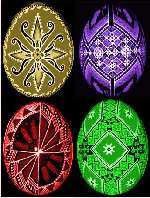|
Picture sample
A design is written on the egg with a funnel shaped tool made of metal and beeswax. The beeswax is continuously heated over a flame to keep the beeswax in a liquid form. After the white portion of the design is covered, the egg is then dipped into a dye bath beginning with the lightest color and progressing to the darkest color.The wax must be heated up, until it is liquid (not permit to boil!) Take a blown out egg for trying. With the feather cut into shape (or the pin-head) you dip into the wax. Be careful, it's hot! Nevertheless you must work rapidly, because the wax confirms fast. Press now the feather (or pin-head) with the wax on the egg and take it fast off again. Repeat this procedure until an ornamentation develops from the individual stamp forms.
The egg is heated over an open flame to melt the wax and the melted wax is rubbed off with Subsequently, you dip the egg into colour for colouring Easter eggs (do not forget the vinegar!). Before you tighten best thin rubber gloves. So you get an egg, which has at the end an ornament in the colour of the egg and which has otherwise the coloured colour. You can bring several layers of wax on the egg. The wax ornaments always produce thereby the previous colour as ornamentation. The last colouring colour will be the final colour of the egg and the ornaments will have the colours of the previous colouring (in the selected order). Consider to begin always with the brighter colours.
If the egg is dried well, the wax is removed with the help of a hot air pistol, or in the baking-oven with 150°C.
|
|
At the end, you polish the egg still carefully with a soft cloth, so that it shines a bit.
Once the egg is removed from the darkest color and dried thoroughly, the wax can be removed exposing the color beneath.
After the wax is removed, each egg is blown out and varnished to a high gloss to add durability and enhance the vivid colors. The eggs are blown out to avoid gasses building up inside the egg which could cause it to explode.
|
|
The most common series is white, yellow, green, orange, red, and black. The portion of the egg that is covered with the wax resists the color of the dye bath retaining the color underneath the wax.
Web stuff
|
 |

